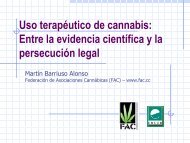Les Rencontres de Biarritz 2007 - THS 10
Les Rencontres de Biarritz 2007 - THS 10
Les Rencontres de Biarritz 2007 - THS 10
Create successful ePaper yourself
Turn your PDF publications into a flip-book with our unique Google optimized e-Paper software.
THE SELF-PERCEIVED MOTIVATION FOR USING ADDICTIVE SUBSTANCES.<br />
A CROSS-SECTIONAL STUDY OF SUBSTANCE DEPENDENT PATIENTS,<br />
BORDEAUX, FRANCE, 2003-2006.<br />
RÉSUMÉ / ABSTRACT<br />
FATSÉAS M<br />
LAVIE E<br />
DENIS C<br />
AURIACOMBE M<br />
Two major motivations for the use of potentially addictive substances are reported: a positive<br />
dimension with a search for euphoria and a negative dimension involving a relief of pain. Both<br />
motivations are rarely explored together. Objective: to <strong>de</strong>scribe the different motivations for<br />
the use of addictive substances in <strong>de</strong>pen<strong>de</strong>nt users and examine their relationship with the<br />
reinforcing properties of the substance of choice and patient individual characteristics.<br />
Methods: subjects were recruited among polysubstance users <strong>de</strong>pen<strong>de</strong>nt on one or more substances,<br />
un<strong>de</strong>rgoing treatment in specialized outpatient clinics, in Aquitaine, France, from May<br />
2003 to May 2006. The subjects answered a self-administered questionnaire evaluating lifetime<br />
self-perceived motivations (hedonic motivation and/or self-treatment motivation) for use<br />
of all addictive substances. They were also interviewed with the Addiction Severity In<strong>de</strong>x, the<br />
Mini International Neuropsychiatric Interview and the Sensation Seeking Scale (SSS).<br />
Results: 240 subjects were inclu<strong>de</strong>d. 49% reported both motivations, 25% reported the hedonic<br />
motivation only and 26% the self-treatment motivation only. The hedonic motivation was associated<br />
with a more frequent choice for strong reinforcing substances and was linked to higher<br />
scores of the subscale Thrill/Adventure of the SSS. The self-treatment motivation was associated<br />
with weak reinforcing substances and was linked to a higher prevalence of current <strong>de</strong>pressive<br />
and anxiety disor<strong>de</strong>rs. Subjects with both motivations had higher scores for the subscale<br />
Thrill/Adventure of the SSS and reported a preference for strong reinforcing substances.<br />
Conclusion: Although subjects were questioned lifetime, half reported only one motivation.<br />
Subjects reporting exclusive motivations differed on personality traits, co-morbidity and substance<br />
of choice.<br />
MOTS CLÉS / KEYWORDS<br />
Non communiqué...<br />
M. Fatséas, E. Lavie, C. Denis, M. Auriacombe.<br />
Addiction Psychiatry, JE2358, INSERM IFR 99<br />
University Victor Segalen Bor<strong>de</strong>aux 2, Bor<strong>de</strong>aux, France<br />
123
















